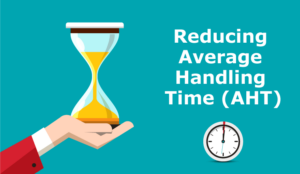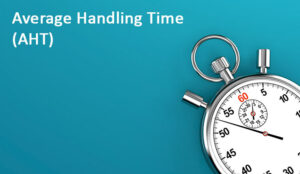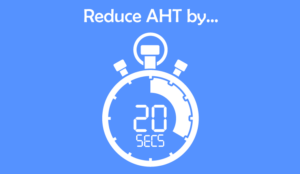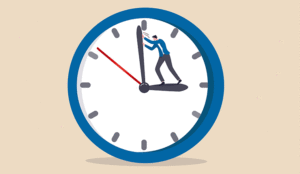Looking to reduce Average Handling Time (AHT) but worried about damaging the customer experience in the process? There are ways around this!
See what our Consultants Panel – including Dan Pratt, Irina Mateeva, Paul Weald, and more – have to say on creating a win-win situation of reducing AHT whilst keeping customers happy.
1. Train Agents to De-Escalate Customer Conflicts Using Empathy
Train agents to de-escalate customer conflicts using empathy, paraphrasing, active listening, and validation techniques.
Contrary to expectation, these methods reduce average handle time because calls go faster with a calmer customer.
Contributed by: Mike Aoki, President, Reflective Keynotes Inc.
2. Be Your Customer and See Where There’s Genuine Room for Improvement

Walk in your customers’ shoes! Make some test calls and interact with your agents. This will allow you to see where you can improve in your process.
Also, double-check your technology supports your agents in reaching the desired customer answer quickly. If your agents need to go through endless apps and tools to find what they need, time adds up.
Contributed by: Irina Mateeva, Founder of RightWFM
3. Avoid Overflowing Sales Calls to Service Agents (and Vice Versa)

Try to avoid overflowing sales calls to service agents and service calls to sales agents.
When an agent answers a secondary call type – that they don’t deal with all the time – it naturally takes them longer to complete the task.
When calls are queuing, it’s intuitive to think that overflowing enhances customer experience, whilst the opposite might actually be true. When you route the call to the right-skilled agent, FCR goes up and AHT goes down – a win-win situation.
Contributed by: Paul Weald, The Contact Centre Innovator
4. Empower Agents So They Don’t Have to Waste Time Seeking Permission

Some of the actions that you can take to reduce AHT would include advisor empowerment, so they don’t have to ask permission, and therefore take even more time, to do the right thing for the customer.
Contributed by: Gerry Brown, Chief Customer Rescue Officer at The Customer Lifeguard
5. Be More Proactive in Training Agents and Pre-Empting Issues

A well-trained team is more adept at resolving issues promptly. Regular training sessions not only enhance agents’ skills but also keep them abreast of the latest industry trends and updates, enabling them to provide faster and more accurate assistance.
Not only that, but embracing a proactive approach to issue resolution minimizes AHT.
By analysing historical data and identifying common pain points, contact centres can pre-emptively address potential problems, reducing the likelihood of repeated queries.
This approach not only saves time for both agents and customers but also showcases a commitment to customer satisfaction.
Contributed by: Dan Pratt, Customer Experience and Business Consultant, Founder & Director DAP Consultancy
6. Don’t Ask Customers to Repeat Pre-Qualifying Information

Stop the processes that are repetitive that waste everybody’s time!
For example, if the customer comes into the agent pre-qualified, having shared an ID, social security, or bank card number via a virtual automated voice prompting system – they shouldn’t have to repeat this information to the agent.
If you can make this key change to your processes, your agents won’t have to ask the customer to repeat themselves and waste 60 seconds’ or 90 seconds’ worth of the call.
This is a great way to reduce AHT, whilst also creating a more positive experience for the customer.
Contributed by: Shep Hyken, Chief Amazement Officer (CAO) at Shepard Presentations LLC
7. Reframe the Challenge to Ask “How Can We Have No Handle Time?”

The framing of “reduce handle time” implies that’s a good thing. But I think it’s not.
So, when next challenged to do this – say no, it’s the wrong question, and instead frame the challenge differently.
For example, “How can we have no handle time?” and “How can we ignore the handle time to get the job done properly first time?”
Contributed by: Peter Massey, MD & co-founder at Budd UK Ltd
8. Work Together to Agree an AHT Benchmark

Agents, and especially contact centre leadership, should be data scientists.
Review customer interaction data for insights, understand existing insights from customers on interactions, and learn how to prevent calls that lead to longer AHT. Consider best practices to implement that would lead to shorter-AHT calls.
Teams should also work together to understand what AHT benchmark is right for them, and work on best practices and implement them, so you can consistently improve on your AHT.
Contributed by: Sue Duris, Principal Consultant at M4 Communications, Inc. and Non-Executive Director for Customer Institute
9. Encourage Agents to Mentally Prepare for Each Call

The number one thing I think any agent can do to help reduce AHT is mental preparation.
This means thinking through the processes of handling the customer’s requirements through the system, and thinking about wording (“how am I going to speak?”).
Any agent can be a top performer in AHT, but this depends upon their preparation and the coaching and mentoring atmosphere of the contact centre and business organization. The headspace investment the agents spend is the only factor separating top-performing agents from everybody else.
Managers should encourage their agents to think, prepare, and then speak to customers, gaining experience but always thinking and preparing to face a customer first.
Contributed by: Dr M. Dave Salisbury, COO at D&C Consulting LLC
10. Always Direct Extremely Complex Calls to Your Best Agents
If the call is extremely complex and requires another skill set, program the IVR to direct these calls to agents that can handle more time-consuming tasks that require complex skills.
Contributed by: Sangeeta Bhatnagar, Founder of SB Global
You can read more about skills-based routing in this article on The Top 10 Call Routing Strategies
Case Study – Stop Customers Having to Contact You in the First Place to Reduce Your AHT to Zero

James Lawther
Here, James Lawther, Director of Squawk Point Consulting, and author of ‘Managed by Morons’, shares his personal experience on how reducing your AHT to zero comes down to getting it right in the first place:
“Before Christmas, I ordered a 5G wireless router from one of the big mobile suppliers. It promised “outstanding internet speeds without cable”. It didn’t work.
I tried to return it, and as I couldn’t do that online, I had to phone a call centre. They wanted my phone number to route me correctly, but I didn’t have a phone number because it was a router and not a mobile phone.
I argued with the machine and then sat in a queue for 20 minutes before I could talk to an agent.
The agent put me through security but unfortunately couldn’t help me. They transferred me to another agent who put me through security again and promised to email me a return coupon (within two working days).
The coupon didn’t arrive. I phoned them. I argued with the machine. I sat in a queue. I spoke to an agent. I passed security.
She transferred me. I sat in a queue, passed security again, and the agent assured me the coupon would arrive by the next day.
It didn’t. I phoned them and argued with the machine. I sat in a queue, passed security and was transferred.
There was another queue and more security, and the agent apologized and promised to send me a new coupon via email in two working days.
The coupon arrived. I took the router to my corner store, where the lovely lady put it in a bag and gave it to a courier. The telephony company emailed me the following day to say they had received it.
Two weeks later, I received an email asking where the router was. I phoned and argued with the machine… queue… agent… security… transfer… queue… agent… security… and was asked to provide the parcel tracking number.
Two weeks later, they sent me an email telling me I would have to pay for the router as they hadn’t received it. I phoned and argued with the machine… queue… agent… security…
I said the magic word “complaint”… transfer… queue… agent… security… tracking number… I was assured the account had been closed and I would receive no further emails. That was a week ago. I haven’t been billed yet!”
11. Use Visual Aids to Help Agents Find the Information They Need

Provide an easily searchable and up-to-date knowledge management system.
Make your knowledge base easier to follow by using visual aids like graphs and flowcharts.
That will help your agents reduce average handle time while still providing efficient issue troubleshooting.
Contributed by: Mike Aoki, President, Reflective Keynotes Inc.
12. Ask Your Quality Team to Identify Conversation Time That Doesn’t Add Value to Customers
It is important to understand that AHT is actually composed of three different elements – Talk time, Hold time, and Wrap time – and they each have different characteristics.
In terms of efficiency improvements, then:
- To reduce hold time, focus on reducing hand-offs, so that more customers get answered by the right agent first time.
- Whilst talk time may well have a positive impact on CX, it’s worth getting your quality team to review calls from the perspective of identifying conversation time that does not add value to customers.
- To reduce wrap time, look for opportunities to use technology that helps agents to automate after-call work activities. For example, reducing cutting and pasting.
Contributed by: Paul Weald, The Contact Centre Innovator
13. Train Agents to Take Down Concise Notes While They Speak to the Customer

Bhatnagar
One contact centre leader, Clare Santos, Director, Knowledge & Quality, Customer Experience, Aviso Wealth, shared with me that agents should take notes as they speak with the customer to keep track of details.
She suggests, “Key words or phrases work best and don’t worry about spelling as you can always edit them during your ACW/Wrap-Up time.
Agents do not need to write a novel, just note the details, clearly and concisely.” It’s a practice that can help speed things up.
Contributed by: Sangeeta Bhatnagar, Founder of SB Global
14. Have a Clear ‘On Hold Policy’

Ask yourself how much time advisors are on hold to other departments, what the service levels of other departments are, and how these impact your area.
Are you planning in isolation, which is causing bottlenecks? Also, have you been clear on how long your agents should wait for other areas before they go back to the customer?
Beware, as this can sometimes be abused as a breather in a busy contact centre, so be clear on your ‘On Hold Policy’ to help reduce AHT in this area.
Contributed by: Garry Gormley, Founder, CEO – FAB Outsourced Solutions
15. Never Stop Agents From Asking “Is There Anything Else I Can Help With Today?”
I had a client who didn’t want their agents to wrap up a call by asking “Is there anything else I can help with today?” as they just wanted their agents to answer one question and move on.
Don’t try this! Taking proactive steps to stop the customer calling back saves time in overall Average Handling Time across the contact centre, as that customer won’t have to go through the whole process of starting over with another agent later on if they do happen to have an additional query.
Contributed by: Shep Hyken, Chief Amazement Officer (CAO) at Shepard Presentations LLC
16. Use AI Bots for Routine and Straightforward Queries

My advice for optimising contact centre AHT, whilst protecting or improving the customer experience, would be to leverage artificial intelligence and automation.
AI bots can handle routine and straightforward queries, swiftly providing information, executing basic tasks, and guiding customers through standard processes.
Meanwhile, machine learning algorithms can continuously improve the AI’s accuracy and effectiveness over time.
Contributed by: Rob Wilkinson, CX Solutions Consultant, EvaluAgent
For more great information on contact centre average handling time, read these articles next:
- How to Measure Average Handling Time (AHT)
- How to Safely Lower Average Handling Time
- 49 Tips for Reducing Average Handling Time (AHT)
Author: Megan Jones
Reviewed by: Xander Freeman
Published On: 21st Feb 2024 - Last modified: 4th Mar 2024
Read more about - Customer Service Strategy, Average Handling Time (AHT), CX, Dan Pratt, Dave Salisbury, Editor's Picks, EvaluAgent, Garry Gormley, Gerry Brown, Irina Mateeva, James Lawther, Mike Aoki, Paul Weald, Peter Massey, Rob Wilkinson, Sangeeta Bhatnagar, Shep Hyken, Sue Duris, Top Story









































